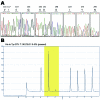Oseltamivir-resistant pandemic (H1N1) 2009 virus, Mexico
- PMID: 21291607
- PMCID: PMC3204764
- DOI: 10.3201/eid1702.100897
Oseltamivir-resistant pandemic (H1N1) 2009 virus, Mexico
Abstract
During May 2009-April 2010, we analyzed 692 samples of pandemic (H1N1) 2009 virus from patients in Mexico. We detected the H275Y substitution of the neuraminidase gene in a specimen from an infant with pandemic (H1N1) 2009 who was treated with oseltamivir. This virus was susceptible to zanamivir and resistant to adamantanes and oseltamivir.
Figures


References
-
- World Health Organization. Pandemic (H1N1) 2009. —update 101. Weekly update [cited 2010 May 21]. http://www.who.int/csr/don/2010_05_21/en/index.html
-
- Secretaría de Salud. Estadísticas de la epidemia. Influenza A (H1N1) [cited 2010 May 17]. http://portal.salud.gob.mx/contenidos/noticias/influenza/estadisticas.html
Publication types
MeSH terms
Substances
LinkOut - more resources
Full Text Sources
Medical
Miscellaneous
